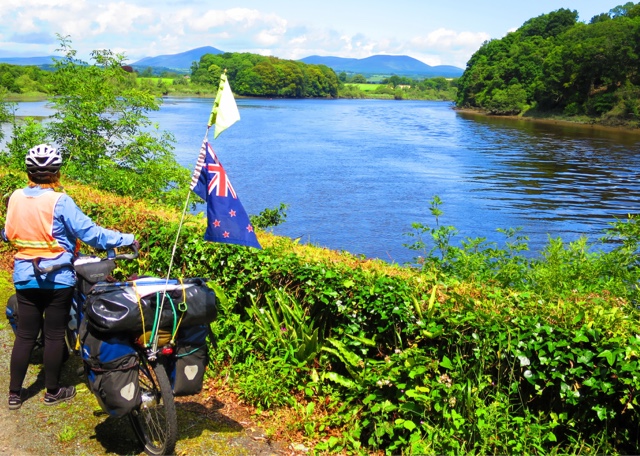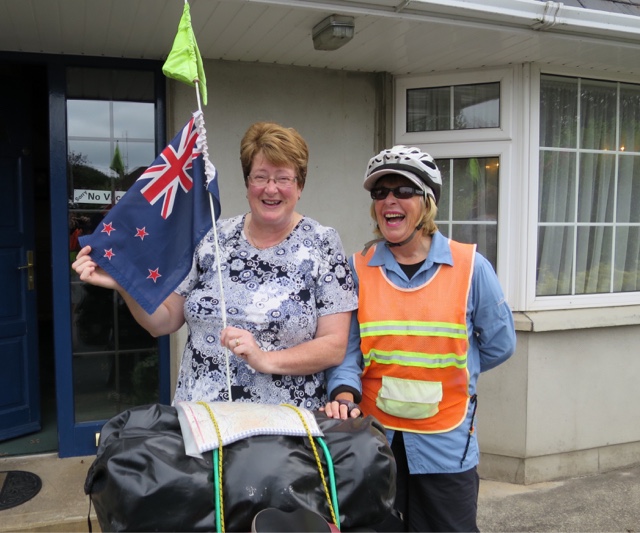Current Location: Tralee, Co. Kerry, Ireland
Distance Cycled on Tandem: 22,116 km
Distance This Trip: 3,090 km
Before us lay the Atlantic, surging against vertical cliffs, the wind buffeting us, the rain holding off.
It was exhilarating riding - the best since we began this trip in Portugal - the kind that makes your senses come alive and leaves nerve ends tingling with the excitement and sheer joy of being alive.
We have had this kind of riding for three days in a row now, but it began before that with a 49 km loop ride from Killarney, Co. Kerry, through the glacial Gap of Dunloe. It's a tourist route, but cars are banned. People are forced to walk, cycle or take what's known here as a jaunting car (horse and cart).
We left our tent and other gear at our campsite and with a much lightened bike pedalled our way up to the Gap, dodging the horse poo, the jaunting cars and the walkers with their twin walking poles clack, clack, clacking on the mostly sealed surface.
The view from the top was of barren hillsides (mountains, the Irish would call them but as New Zealanders that seems to be stretching it a bit), a small river and a lake, the tones muted, almost monochrome in the overcast. It was bleak, but we are getting used to it. It's Ireland and in its way it is truly beautiful.
We raced down the other side, had coffee and scones at Lord Brandon's Cottage and then found an easy way back to Killarney on a path meant for walkers only.
A couple of days later we were on our way to Dingle in the sun, then a loop around Slea Head and on to Tralee.
The coastal scenery has as Judy says, been spectacular. It's not pretty in that Kiwi-sunshine-and-summer-cove kind of way. It's West Coast wild minus the mosquitoes and it just keeps on giving - around every bend lies another great view. And what better way to see it than in its bleakness - the wind tearing at our clothing, the bike buffeted by gusts so strong it becomes a battle between man and nature.
No wonder we feel alive, energised, and no wonder someone has come up with a marketing strategy which calls this the "Wild Atlantic Way".
On the loop around Slea Head. This was a relatively sheltered spot and we sat and ate our fruit scones.
Coffee break, Slea Head. The elderly owners of the house/cafe have lived here for years. Originally they ran the property as a B and B, but now find it too much. They do a good line in rhubarb pie with cream.
There are other things, beyond the scenery, that make this place so special to us. One is the well known friendliness of the Irish - the stories we have all heard are true.
There's the music. On a wet night in Dingle we visited a couple of pubs - one delivered up foot tapping music of the traditional kind while the other aimed at a younger audience. On a screen at the back we saw the last seven minutes as the All Blacks came from behind to beat South Africa. Elated, we attempted to leave the bar but were waylaid by a group of young men who insisted we join in a wild, uncoordinated dance to "heh, heh, what's going on". Judy's umbrella served as a pretend microphone until we were finally spat out the door, still fizzing with excitement.
And then there is Ireland's history that goes back to the hunter gatherers who arrived at least 9,000 years ago. The signs of occupation through the ages are everywhere in this sometimes lonely landscape - from ancient burial chambers to castles, strange beehive shaped houses and cottages abandoned during the potato famine.
On that ride round the Slea Peninsula we stopped at Dunberg Fort, where carbon dating suggests humans lived around 580 BC.
Dunberg Fort is built on a sheer cliff, and has a defensive structure that includes four lines of banks which originally would have wooden palisades on top.
They must have been tougher than us - the cold drove us indoors to watch an audio visual. Throughout it, the office cat sat on Judy's lap demanding attention.
On the third day we rode from Dingle to Tralee, a short hop of 52 km and made even quicker by that wind - this time like a firm hand pushing from behind. At times GPS George was clocking us at 40 kph and we surged up the hills despite our load.
Along the way, more history, this time in the village that was the home of Antarctic explorer Tom Crean. We spotted the pub first. It was called the South Pole Inn. Across the road was a statue of Crean, there were Crean walkways and even a lump of South Georgia rock brought back to help remember him.
After three polar expeditions and a long naval career, Tom Crean returned to the place of his birth, married, had children and became a publican.
We shivered in the cold and went inside the pub which Crean owned after three Antarctic expeditions and a long naval career. The walls were covered with photos - some familiar - of the ships and men who risked their lives to explore the remotest continent on earth.
Camera fogs up in the warmth at the South Pole Inn.
I tried to take photos of the bar but the rain had got at my camera, fogging the lens. It's the sort of thing you might expect at the South Pole, but then again this is Ireland in a bad summer.
Anyone remember Laraine Stollery? A New Zealander, she won the Rose Of Tralee competition in 1966 and is immortalised in the Rose Gardens in Tralee.




















































